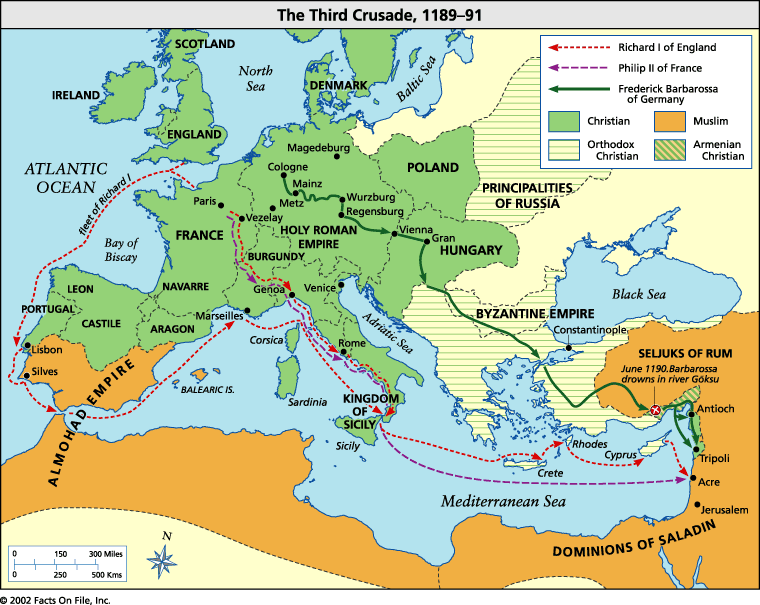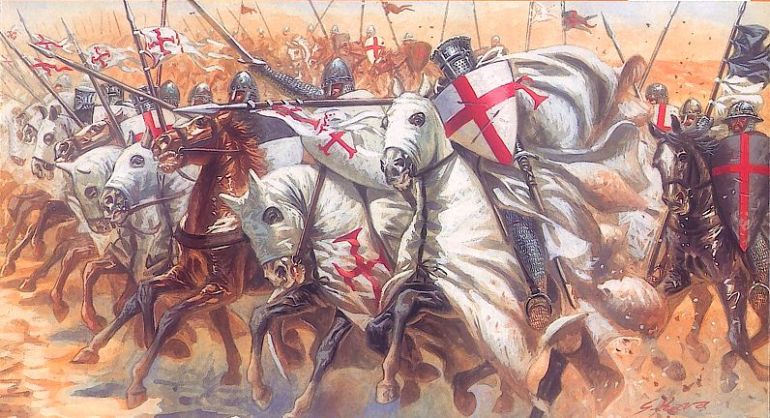The Islamic Conquests began in the 7th century on the Arabian Peninsula. In the first 100 years of its existence, Islam established the largest pre-modern empire up to that time, stretching from the borders of China in the east, through India and Central Asia, the Middle East, North Africa, Egypt, Sicily to the Iberian Peninsula (Spain), in the west.
The Sasanid Empire in what is now Iran ceased to exist under the Muslim conquest, as did much of Byzantium, seat of the Roman Empire in the east. Europe itself narrowly escaped subjugation when Charles “The Hammer” Martel defeated the army of Abdul Rahman al Qafiqi at Poitiers (Tours) in October, 732.
 Estimates suggest that the second of four major Caliphates, that of the Umayyad based in Damascus, Syria, was over 5 million square miles, larger than any modern state with the sole exception of the Russian Federation.
Estimates suggest that the second of four major Caliphates, that of the Umayyad based in Damascus, Syria, was over 5 million square miles, larger than any modern state with the sole exception of the Russian Federation.
The First of the Christian Crusades was launched by Pope Urban II on November 27, 1095, in response to an appeal from Byzantine Emperor Alexios I Komnenos, who was requesting help in defending Constantinople against the invading Seljuq Turks.

Such a request was nothing new. The Reconquista in Spain had not yet reached the mid-point of its 781-year effort to overthrow Muslim rule, and European knights traveled to Spain on a regular basis to assist in the effort.
Once in Anatolia (modern day Turkey), the ancillary goal of freeing the holy city of Jerusalem itself and the Holy Land soon became the principal objective, as Jerusalem had by then been under Islamic rule for 461 years. Jerusalem was recaptured on July 15, 1099, following a siege of six weeks.
The County of Edessa was the first Crusader state to be created, and the first to go, falling in 1144 and leading to the second crusade. Mostly notable for its failures, the one major success of the second crusade was when it stopped on the way to the Holy Land, helping a much smaller Portuguese army overthrow Muslim rule in Lisbon. Two kings then marched two separate armies across Europe into Anatolia, only to be soundly defeated by the Turks.

A Kurdish leader arose at this time to become Sultan, founding a dynasty which would last for eighty-nine years. His name was Salāḥ ad-Dīn Yūsuf ibn Ayyūb, better known as Saladin, a Sunni Muslim who rose to greatness in a Shi’ite world.
 No less a figure than Dante Alighieri counted Saladin a “virtuous pagan,” ranking among the likes of Hector, Aeneas, and Caesar.
No less a figure than Dante Alighieri counted Saladin a “virtuous pagan,” ranking among the likes of Hector, Aeneas, and Caesar.
While Christian leaders in the Middle East fell to squabbling among themselves, Saladin united Syria, Egypt, Mesopotamia, Yemen and parts of North Africa under the Ayyūbid dynasty.
A crusader army some 20,000 strong was caught out in the open in the desert heat of Summer, near a pair of extinct volcanoes called the “Horns of Hattin”. Parched with thirst, exhausted and demoralized, Muslim armies under Saladin captured or killed the vast majority of these Crusader forces on July 4, 1187, putting an end to Christian military power in the Middle East and opening the way to the recapture of every Crusader state, save one. Jerusalem itself fell on October 2.
Pope Urban III is said to have collapsed and died, upon hearing the news.
Within days of his election, Pope Henry VIII called for a third Crusade. King Henry II of England and King Philip II of France were at war at this time, but that was set aside and the pair began preparations to reconquer the Holy Land. An extremely unpopular tax of 10% on all revenues and movable goods was imposed by the Church, and enforced under pains of imprisonment or excommunication. This “Saladin Tithe” raised 100,000 marks of silver: about 800,000 ounces.
 The aging Holy Roman Emperor, Frederick I “Barbarossa” (Red Beard), was the first to go, taking up the cross at Mainz Cathedral in March, 1188. Emperor Frederick drowned crossing the Saleph River in Asia Minor in June 1190, after which most of his army of 100,000 returned to Germany.
The aging Holy Roman Emperor, Frederick I “Barbarossa” (Red Beard), was the first to go, taking up the cross at Mainz Cathedral in March, 1188. Emperor Frederick drowned crossing the Saleph River in Asia Minor in June 1190, after which most of his army of 100,000 returned to Germany.
Henry II of England died in the meantime, leaving his son Richard I “Coeur de Lion” (Lion-heart) to lead the crusade with Philip in the summer of 1190.
Richard took time to conquer Sicily on the way to the Holy Lands, where King Tancred I was holding Richard’s sister Queen Joan, prisoner. He reached Cyprus that May, there pausing long enough to marry Berengaria of Navarre, thus alienating his alliance with the French King, who considered Richard betrothed to his half-sister, Alys.

Richard landed near Acre in June 1191 to find the city under Muslim occupation, and under siege by the forces of Guy de Lusignan, himself held under siege by the armies of Saladin.
The fall of Acre that July led to a number of meetings between Richard and Saladin’s brother Al-Adil, from which nothing resulted. The Crusaders lost all patience by August, believing Saladin to be dragging his feet, and decapitated 2,700 Muslim prisoners in full view of his army. Saladin retaliated by murdering every Christian captive under his control.
If the Crusaders were to retake the holy city of Jerusalem, they first had to take and hold the strategically important port city of Jaffa, some 75 distant.
Richard’s personal courage and skill as a commander was on full display on the march south. Ever mindful of the disaster at Hattin, Richard understood the need for water and the danger of heat exhaustion. The 10,000 infantry and 1,200 heavy cavalry of the Crusader army moved only in the cool hours of the early morning, the crossbowmen of the infantry corps on the landward side, with the allied fleet to their right providing resupply and succor for the wounded.
The hit & run tactics of Muslim archers were near-constant, the rearguard of the Knights Hospitaller forced to walk backward, to engage the adversary. Any spaces in the line were quickly filled by Arab horsemen, who finished the stragglers with sword or with mace. The Kurdish historian and eyewitness Baha al-Din ibn Shaddad described heavily armored knights on the march to Jaffa, seemingly unhurt despite multiple arrows, sticking out of their backs. The power of the Christian crossbow was another matter, striking down Arab horses and riders, with ease

Harassing attacks gave way to pitched battle this day in 1191 near the ancient fortified city of Arsuf, proving Richard’s personal courage and skill as a commander, while putting a dent in Saladin’s reputation as the invincible warrior King.
The Latin history of the third crusade Itinerarium Regis Ricardi “There the king, the fierce, the extraordinary king, cut down the Turks in every direction, and none could escape the force of his arm, for wherever he turned, brandishing his sword, he carved a wide path for himself: and as he advanced and gave repeated strokes with his sword, cutting them down like a reaper with his sickle, the rest, warned by the sight of the dying, gave him more ample space, for the corpses of the dead Turks which lay on the face of the earth extended over half a mile.”
Two times Crusader armies came within sight of Jerusalem, never suspecting that, within the city, “Saracen” morale was so low that the city could have been theirs for the taking. Meanwhile, factions within the Crusader armies fell to bickering, with half wanting to push on to Jerusalem, the other wanting to attack Saladin’s base of power, in Mamluk Egypt.
In time, the Crusader and the Sultan came to hold a degree of respect for one another. Legend has it that, at one point in the fighting around Jaffa, Saladin even sent Richard a fresh horse, after one was killed beneath him. The pair even discussed marrying Joan off to Saladin’s brother, Al-Adil, with themselves becoming co-rulers in Jerusalem. The plan might’ve worked, too, until the Roman Church got wind and threatened excommunication if Richard carried it out.
I have not been able to learn what Joan herself, thought of the match.

Time finally ran out for Richard and Saladin, both. The Christian army was decimated by disease. Fierce quarrels between German, English (Angevin) and French contingents threatened to break up the Crusader army. Richard himself was gravely ill, near despair of ever regaining his health. On top of that, his little brother John was plotting against him, with the connivance of the French King Philip.
Richard Lion-heart no longer had the strength to challenge Saladin for Jerusalem. Saladin, for his part, had serious morale problems, after repeated defeats at the hands of the Crusaders.
With Saladin’s brother Saif adDin acting as intermediary, the King and the Sultan concluded the Treaty of Jaffa in 1192. The fortifications at Ascalon were to be dismantled, in exchange for which Christians would continue to hold the coast from Jaffa to Tyre. Jerusalem would remain in Muslim hands, while unarmed Christian pilgrims and traders would be guaranteed free passage to visit the Holy Sepulcher of the Lord in peace, without the exaction of tribute or tax. Further, Christian traders were permitted the possession objects for sale throughout the land, thus permitting such traders right of free commerce.

Sultan Salāḥ ad-Dīn Yūsuf ibn Ayyūb died of a fever the following March, and was buried in the garden outside the Umayyad Mosque in Damascus. Saladin’s kingdom and the Crusader states would remain at peace, for a period of three years.
Seven centuries later, German Emperor Wilhelm II donated a new marble sarcophagus, to the tomb of the Sultan who had reclaimed Jerusalem from the Crusaders.
Foul weather drove King Richard I ashore near Venice, where he was captured by Duke Leopold of Austria and handed over to German Emperor Henry VI and held for ransom. This time, the tithe would amount to 25%, raising about 1.2 million ounces of silver, and forever answering any questions as to what might constitute a “King’s Ransom”.
A bolt from a crossbow left Richard Coeur de Lion mortally wounded on April 6, 1199, while besieging the castle of Châlus, in central France. He was 41.
Richard was destined to be succeeded by his brother John, after all. John became such an unpopular King that his Nobles and their French and Scots allies forced him to sign the “Great Charter of the Liberties”, the Magna Carta, at a place called Runnymede.

Nearly 600 years later, the document would influence early government in the thirteen American colonies and the formation of our own Constitutional Republic, but that must be a story for another day.
If you enjoyed this “Today in History”, please feel free to re-blog, “like” & share on social media, so that others may find and enjoy it as well. Please click the “follow” button on the right, to receive email updates on new articles. Thank you for your interest, in the history we all share.



You must be logged in to post a comment.